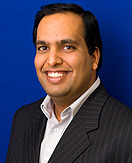News
Avoiding space collisions focus of research
-
 Print
Print -
 Comments
Comments
-

Puneet Singla will use his award from the Air Force Office of Scientific Research to develop mathematical models to improve space situational awareness. Photo: DOUGLAS LEVERE
It may not look that way to us earthlings, but the U.S. Air Force estimates that there are approximately 22,000 resident space objects in outer space, and the number is growing. In order to prevent potentially catastrophic collisions with satellites and other important space objects, engineers are developing new techniques to establish “space situational awareness” so countries can better keep track of these objects.
Puneet Singla, assistant professor in the Department of Mechanical and Aerospace Engineering, School of Engineering and Applied Sciences, was chosen recently to receive a prestigious Air Force Office of Scientific Research award to develop more robust mathematical models to assess space situational awareness. The highly competitive Young Investigators Research Program award will fund Singla’s research into “Information Collection and Fusion for Space Situational Awareness.”
“Currently, the U.S. Air Force collects information for the purpose of space surveillance through a global network of radars and optical sensors to maintain a map of more than 20,000 resident space objects,” says Singla. “Because of the large number of these objects and the limited number of sensors available, it is impossible to maintain persistent surveillance on all objects so the observational data is limited.”
Singla points to the accidental collision between Russia’s Cosmos 2251 satellite and a U.S. Iridium satellite as evidence of the limited usefulness of the current methods of doing space surveillance.
He notes that it isn’t just the number of objects and difficulty tracking them that must be taken into account.
To determine the location and orbit of resident space objects, Singla explains, researchers also need to consider mathematical models, which must take into account the modeling of space weather effects, such as solar radiation “wind,” atmospheric drag from air molecules and higher-order gravity potentials that produce disturbances for the motion of space objects.
To improve the accuracy of space situational awareness, Singla will combine observational data with mathematical models to provide greater understanding of these physical phenomena and how they affect the position and trajectory of resident space objects.
“The most critical challenge here is to provide a quantitative assessment of how closely our estimates reflect reality in the presence of model uncertainty and other factors relating to measurement errors and uncertainty,” he says.
The goal of the research is to design a robust methodology for optimal sensor management while taking into account these uncertainties.
“The analysis tools we develop will enable accurate assessment of risk and consequently lead to more informed decisions, which potentially will prolong the lifetime of our space assets, such as satellites and space vehicles,” he says.
Singla’s research group also develops mathematical tools to quantify uncertainty and has applied these tools to applications ranging from rigid body attitude estimation and orbit estimation in astrodynamics to tumor motion tracking and the dispersion of toxic materials in the atmosphere.
He also works with an interdisciplinary team in UB’s strategic strength in Extreme Events: Mitigation and Response that is studying the eruption of the Eyjafjallajokull volcano in Iceland.

Reader Comments